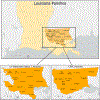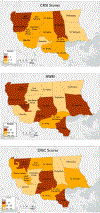Development of Community-Level Capacity of Resilience to Natural Hazards for Environmental- and Social-Justice-Challenged Communities: 1. Approach, Concepts, and Assessment of Existing Information
- PMID: 38756353
- PMCID: PMC11094659
- DOI: 10.3390/su16030963
Development of Community-Level Capacity of Resilience to Natural Hazards for Environmental- and Social-Justice-Challenged Communities: 1. Approach, Concepts, and Assessment of Existing Information
Abstract
Impoverished and under-served communities are often exposed to the worst environmental and climate hazards. Identifying these communities and building their resilience capacity to withstand such hazards is a vital justice aspect of environmental management. Building community resilience requires five activities: (1) examination of existing information, (2) community engagement and assessment of local knowledge, (3) development of reasonable strategies to build resilience, (4) implementation and these strategies, and (5) monitoring and transability of the process. This manuscript examines the first component of this process. The attributes of multiple parishes in Louisiana are examined using available data and existing models of human well-being, community resilience, and environmental/climate/socioeconomic justice. These existing models and tools were used to determine parish-level resilience to natural hazards including flooding, hurricanes, and other potential natural climatic hazards in central Louisiana (U.S.). Through consultation with state officials and local community groups, candidate environmental justice (EJ) and social justice (SJ) communities were selected to develop resilience capacity enhancement plans to address potential adverse parish and community outcomes of natural hazard events. Of the available parishes, St. Helena Parish was selected as an entity that would significantly benefit from resilience capacity building. The remaining two activities, community engagement and strategy development, will be examined in sister manuscripts. Continuing studies, to be described elsewhere, will describe community engagement and the determination of strategies, implementation plans, and the monitoring of the success of these strategic implementations.
Keywords: CRSI; capacity building; climate; community; natural hazards; resilience.
Conflict of interest statement
Conflicts of Interest: Author Andrea Lamper is employed by the company CDM Smit at present but was working for EPA at the time of the work. Author Mason Lowery is employed by the company Oasis Systems, LLC at present but was working for EPA at the time of the work. The remaining authors declare that the research was conducted in the absence of any commercial or financial relationships that could be construed as a potential conflict of interest.
Figures








References
-
- Holling CS Resilience and stability of ecological systems. Annu. Rev. Ecol. Syst 1973, 4, 1–23.
-
- Davidson JL; Jacobsson C; Lyth A; Dedekorkut-Howes A; Baldwin CL; Ellison JC; Holbrook NJ; Howes MJ; Serrao-Neumann S; Singh-Peterson L; et al. Interrogating resilience toward a typology to improve its operationalization. Ecol. Soc 2016, 21, 27.
-
- Therrien M; Usher S; Matyas D Enabling strategies and impeding factors to urban resilience implementation: A scoping review. J. Contingencies Crisis Manag 2020, 28, 83–102.
-
- Bruneau M; Chang SE; Eguchi RT; Lee G; O’Rourke TD; Reinhorn AM; Shinozuka M; Tierney K; Wallace WA; von Winterfeldt D A framework to quantitatively assess and enhance the seismic resilience of communities. Earthq. Spectra 2003, 19, 733–752.
-
- Ouyang M; Duenas-Osorio L; Min X A three-stage resilience analysis framework for urban infrastructure systems. Struct. Saf 2012, 36–37, 23–31.
Grants and funding
LinkOut - more resources
Full Text Sources
